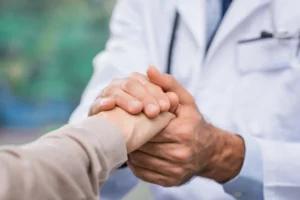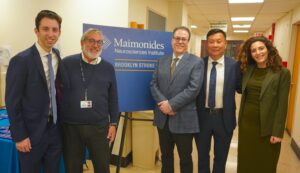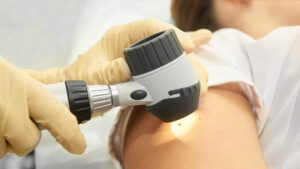Many patients with Aortic Aneurysms do not experience symptoms so the diagnosis can come as quite a surprise. Dr. Robert Rhee and Dr. Mahmoud Almadani discuss treating Abdominal Aortic Aneurysms, or AAA, and the ground breaking advances that are available to patients.
Transcript
Caitlin Whyte (Host): Many patients with aortic aneurysms do not experience symptoms, which is why some diagnoses can come as a surprise. So, to talk about treating abdominal aortic aneurysms, and the groundbreaking advances available are Dr. Rhee, the Chief of Vascular Surgery and Dr. Mahmoud Almadani, a Vascular Surgeon at Maimonides.
This is Maimo Med Talk. I’m your host, Caitlin Whyte. Dr. Rhee, kick us off here. Tell us about aortic aneurysms in general. What happens when one occurs?
Robert Rhee, MD (Guest): Aortic aneurysms are weakness of the main artery in the body, which is the aorta. The aorta starts right outside of the heart and it travels all the way down to the pelvis. And an aortic aneurysm can occur anywhere along its route. When it occurs in the chest, it’s called a thoracic aneurysm. And when it occurs in the abdomen, it’s called an abdominal aortic aneurysm. Aortic aneurysms in general, can occur anywhere and is a result of weakening of the wall. Sometimes connective tissue disorders can cause aneurysms, but that’s rare.
Usual aneurysm occurs because of damage to the wall of the aorta from various sources, it could be related to diet. It could be related to family history. It could also be related to external factors such as smoking and, and inherent hypertension. So, it’s a combination of effects. The pathophysiology or the mechanism is really not clearly defined except that we know all the risk factors. So, when an aortic aneurysm occurs, it’s usually the result of all the factors that we talked about. When it does occur, an aortic aneurysm is defined as anything, enlargement of the aorta more than its normal or natural size. The abdominal aorta is about two to 2.5 centimeters.
The thoracic aorta is anywhere from 2.5 to three centimeters. So, anything which is 50% greater than that diameter is a weakening of the wall and an enlargement. Sort of like a weakened portion of a inner tube that starts to balloon out before it pops. The danger is that when the weakened wall starts to enlarge, it can actually rupture. And, and if it does rupture, it’s usually catastrophic whether it’s in the chest or in the belly. The mortality rate, or the survivability is extremely low. Only about 85 to 90% of the patients actually, only have about five to 10% of the patients survive any type of an aortic aneurysm rupture. So, the idea is to treat them before they actually can rupture or cause problems.
Host: And you kind of touched on my next question, but what are the different kinds that can happen?
Dr. Rhee: Generally, these aortic aneurysms are called silent killers because they don’t cause symptoms usually until they start having such weakness in the wall that the blood starts coming out of the aorta. So, that’s considered a rupture or a leak. And by that time it’s almost too late. So, the whole medical process involves prophylactic or preemptive treatment of these aneurysms before they start bleeding internally.
Host: So, if I am diagnosed with an aortic aneurysm, what happens first? How urgent is treatment?
Dr. Rhee: Aortic aneurysms can vary in size and medical studies have shown that size is directly proportional to the risk of rupture. So, in the thoracic aorta, we generally think about fixing the aneurysm between 5.5 and six centimeters, and then the abdominal aorta, we think about fixing them between five and 5.5 centimeters, depending on the native size of the aorta. We have a smaller size tolerance for women because women have smaller aortas to begin with.
So, it’s all relative to the native size. Generally, when a patient is diagnosed with an aortic aneurysm, they’re referred to a vascular surgeon for either monitoring or treatment. When we see the patients initially, we have an assessment of the size, either through a CT scan or an abdominal ultrasound, and today’s discussion will primarily revolve around abdominal aortic aneurysm. So, I’ll focus more on that, but an abdominal ultrasound will be able to accurately depict the actual size of the aneurysm. If the aneurysm is less than five centimeters, we generally recommend conservative treatment with tight blood pressure control, smoking cessation therapy, cholesterol control, possibly adding some antihypertensive medications or statins to control the cholesterol.
If the aneurysm is five centimeters or higher, the risk of rupture is significant enough to warrant an intervention at that time. But most aneurysms when we see them early on, are diagnosed incidentally with a CT scan that was done for other reasons like prostate cancer or bowel problems. And because these are considered silent killers, they don’t really cause symptoms until they become problematic and they’re large enough to leak inside.
Host: And Dr. Almadani, let’s dive into treatments, starting with non-surgical options. What are some that are available?
Mahmoud Almadani, MD (Guest): Well, so the current approach to the medical management of aortic aneurysms mainly focuses on patients with smaller aneurysms. And those are the patients that do not yet meet the criteria of repair. Once you have a large enough aneurysm, then essentially you need to be repaired surgically. But when you have a smaller aneurysm, this is where a medical management kind of is key and plays a role. And it’s been well studied that lifestyle modification through either smoking cessation and strict management of high blood pressure will reduce a patient’s risk of aneurysm rupture.
Host: And then when it comes to surgery, what do we have in that category?
Dr. Almadani: Generally speaking, there are two types of surgical options, a traditional open repair and an endovascular repair. In this day and age with the incredible advances in endovascular technology, open repair tends to be reserved for patients who cannot undergo an endovascular repair. An endovascular repair is a minimally invasive approach performed by essentially excluding the aneurysm through groin access. Generally it’s well tolerated by most patients. Recovery is quick, involves one overnight hospital stay for observation. However, despite the advances in endovascular device design, there still remains a number of constraints, mainly anatomic constraints that mandate an open repair. An open repair is obviously a bigger operation than an endovascular one, done through an abdominal incision, where the aneurysm is controlled, opened and replaced with a graft. This type of surgery obviously requires general anesthesia, a longer hospital stay with closer patient monitoring and longer recovery time after surgery.
Host: Looking forward, what happens after treatment? You know, we’re in recovery. Can I get another aneurysm?
Dr. Almadani: You know, whether endovascular or open surgery is performed, technical success and overall longterm results are excellent with both approaches. However, I think the key is post-operative follow-up and surveillance for continued success. Surveillance after surgery allows us to essentially assess for two things. Number one, to ensure the integrity of the repair, whether it’s an open or an endovascular approach. And number two, which is important and people often forget is that patients with abdominal aortic aneurysms, even after their aneurysms are treated are still prone to developing other aneurysms, whether it’s in other parts of the abdominal aorta, or like Dr. Rhee was talking about earlier in the thoracic aorta and even arteries of the lower extremities. So, the key is long-term surveillance.
Host: Now, Dr. Rhee, I understand you’ve been involved in developing a groundbreaking new treatment for some of the highest risk patients. Can you tell us about that?
Dr. Rhee: Sure. What I have been involved with for probably almost 10 years now is to help develop a third generation endovascular device that will allow us to treat patients with this endovascular approach because of its benefits due to shorter hospitalization, faster recovery, less chance of having complications during the actual correction surgery. As Dr. Almadani pointed out, many of these patients do not qualify for this endovascular repair because of anatomic restraints. And one of the major anatomic restraints is that when we put these stent grafts or the endovascular device in it has to form a seal in the beginning part of the aneurysm so that the flow can be diverted down to the lower extremities without adding pressure to the aneurysm itself. So, that’s seal zone is often high risk, meaning it’s not ideal for the endovascular device to maintain a seal, either in the short term or longterm. So, through multiple inputs of physicians, including myself and many European, as well as American physicians, the company has developed a device which can be actually adjusted to the anatomy during the deployment of the device and to actually take advantage of every millimeter of the seal zone. So, this allows a much broader extension of the endovascular techniques to a group of patients that were really only best served with an open aneurysm repair. So, in effect, this device will allow us to treat patients with greater safety, greater efficacy, and less risk in the long run.
Host: Well, Dr. Rhee, anything else we didn’t touch on that you’d like to add?
Dr. Rhee: The only thing that I would add is that essentially this new device will open up a horizon for a vascular surgeon to be able to treat patients who normally would have had to have an open repair. And fortunately, Maimonides Medical Center was the lead center in the trial. Because I served as the national PI. Principal investigator for this trial with over 50 institutions in the country participating in the trial. So, it was recently FDA approved for use in January after three years of clinical trial work. And I’m happy to say that this device is now available for use in most medical centers.
Host: And Dr. Almadani, anything else to add?
Dr. Almadani: Yeah. You know, I think the take home message here is that the management of an aortic aneurysm is something that a lot of physicians would consider a lifelong commitment and it really requires appropriate patient education and counseling. This is, you know, our goal here at the Maimonides Medical Center, the Aortic Center, where we look after these patients from the moment they’re diagnosed with an aneurysm to treatment and for the rest of their life.
Host: Well, Doctors, thank you so much for your time and for this information today. To learn more, you can always visit us online at maimo.org and check out all of our other podcasts for topics that may interest you. This has been Maimo Med Talk. I’m your host, Caitlin Whyte. Stay well.







